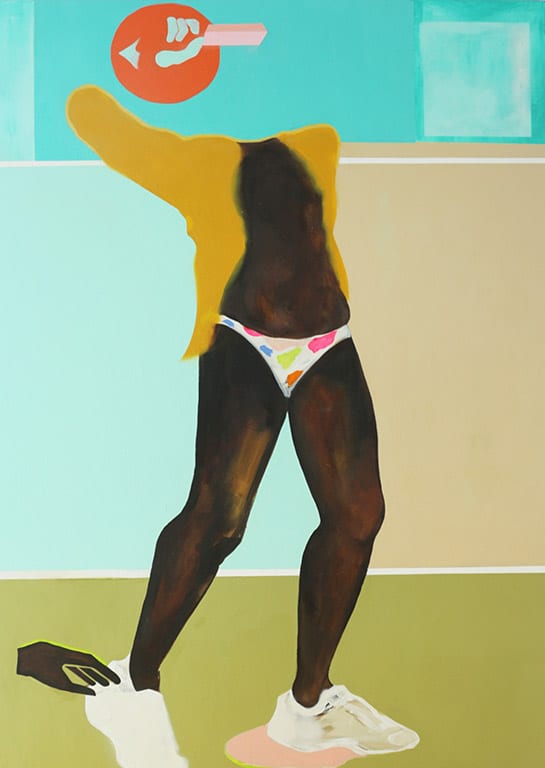New Contemporaries has played a key role in the story of contemporary British art since 1949. The organisation, which supported the early careers of Derek Jarman, Gillian Wearing, Tacita Dean, Mark Leckey, Mona Hatoum, Chris Ofili and more, offers an essential platform for new artists to expand their practice and gain recognition. In a challenging year for the creative industries, their mission has become perhaps more important than ever: to help the next generation and ensure the long-term sustainability of emerging practices. Director Kirsty Ogg speaks to Aesthetica about this new arts landscape – highlighting their most recent cohort of talents, whose work is on view online and in-person at South London Gallery.

A: What’s different about Bloomberg New Contemporaries this year?
KO: We had originally planned that Bloomberg New Contemporaries 2020 would launch in September 2020 at Humber Street Gallery and Ferens Art Gallery, two of Hull’s foremost contemporary art spaces. In addition to the exhibition, we wanted to engage with other arts organisations, educational institutions, communities and artists in the city. Covid-19 restrictions meant that things didn’t go quite as planned, and we took the difficult decision with our partners to postpone working together until 2022, when we will be able to have a greater impact on the selected artists, audiences and local artistic community In Hull.
In response to the pandemic, we created a digital platform, designed by the innovative design studio HATO, to host the 36 artists selected for this year’s show and their works. This new platform also contains lots of other brilliant content in the form of audio contributions by Morgan Quaintance, Adham Faramawy, Sarah Perks and Tendai Mutumbu.
Occupying the digital realm in advance of the Bloomberg New Contemporaries 2020 exhibition opening at the South London Gallery this month (May) prompted us to address a number of questions around the reception of work digitally and physically. During last year, artists, institutions and audiences increasingly occupied digital spaces, creating new and exciting content for a wide variety of audiences. Morgan Quaintance and Adham Faramawy have really helped us think through what opportunities the digital space might, should and could offer to our artists and audiences, especially for an organisation with over seven decades of predominantly gallery-based exhibition-making. How does this dominant history impact working digitally? Will comparison still be made to IRL experiences?
Because of the impact that COVID-19 has had on the sector and especially artists, this year’s Bloomberg New Contemporaries could be seen as even more urgent and necessary than before in that we have found a way to continue to support emerging and early career artists in really challenging circumstances. The loss of opportunities to show work and earn money means that these artists are more vulnerable than before, whilst many of the themes around social and racial justice that are addressed in the selected work are even more pertinent.
A: Has launching the digital platform presented any new opportunities – both curatorially and for the artists themselves?
KO: Yes it has. The platform has allowed us to add and link to material in a much more dynamic way than we would have been able to with a physical catalogue. Alongside the artists’ images, texts, sounds and moving image work, you will find artists’ blog, vlogs and a brilliant tour of the platform by Tendai Mutambu. Tendai is one of the new generation of curators and writers, alongside Chloe Austin, Sophie Bownes, Priyesh Mistry, Riet Timmerman, Lily Tonge and George Watson whom we invited to contribute to the platform. Their considered follow-up questions in response to the artists’ work helped give further insights into the selected artists’ practices as well as expand the networks for the artists and New Contemporaries. In collaboration with the artists we also created a reading list and each of the artist pages has been tagged as another way of engaging with this year’s cohort’s work.
A: Who are the 2020 selectors? What were they looking for?
KO: In 2020, the rigorous two-part selection process was led by a panel of three brilliant internationally-renowned artists Alexandre da Cunha, Anthea Hamilton and Linder. We do the selection process blind, so they had no knowledge of the applicant’s gender, age, nationality or education whilst reviewing submissions.
Hinted at in the selected works are the concerns and themes of the selector’s own work – from Linder’s investigation of performativity and radical feminism; Anthea’s interest in appropriation and the surreal; and Alexandre’s focus on materiality and abstract forms, the selectors aren’t presented with a specific agenda. They look for work that is relevant and speaks to them in a direct way.
A: What are the key themes explored by this year’s cohort?
KO: Like every New Contemporaries exhibition, there is a wide variety of themes explored by the selected artists. Identity Politics and Art Education is one theme addressed in the work of Rene Matić, Ashleigh Williams and Jung Yun Roh, who highlight experiences of going to art school in contemporary Britain. These artists explore themes of identity, class and multiculturalism in their moving image works; addressing the white gaze; and the inequalities in how education is funded for students.
Dislocation and Home is addressed by Edwin Mingard who worked with young homeless people to create a film that poignantly reveals the reality of their lives. Nimmi Hutnik’s ink drawings on paper narrate a single woman’s Friday night in from a personal perspective, whilst Kimie Minobe’s moving image work is an intimate documentary of her family home in the USA.

A: Can you give some examples of particularly timely works – engaging with identity politics, cyber worlds or the idea of home?
KO: All the works selected reflect the world in which they were made. Through moving image Maria Mahfooz creates avatars to demonstrate experiences of racial stereotypes and from her own perspective as a young muslim woman; Chen Si-zuo transforms paintings into androgynous, animated characters in a moving image work that questions cyber femininism and gender binaries; Sangbum Ahn’s documentary film explores artificial intelligence and how this may connect to spirituality and well-being through our relationships with machines thinking and working like humans and pets.
A: Why is it so important to champion emerging artists from UK art schools right now?
KO: Throughout our history, we have remained responsive to the ever-changing needs of artists and a constantly evolving sector. Right now, as we emerge from a really challenging 12 months, it feels doubly important that we remain attentive to artists’ needs and how best to make their works public. The digital space has opened up conversations around access, global reach and engagements from a range of perspectives. Whilst our new digital platform initially launched as an alternative way of presenting this year’s cohort, moving forward we want to continue to test how we address these critical concerns about access and engagement too.
During the first lockdown, we very quickly created two funded digital one-month residencies in response to the fact that so many of the artists in our community had been badly affected financially by the pandemic through work being cancelled and the loss of income from sales etc.. COVID-19 has compounded the precarious nature of our sector, especially for those at the start of their careers. They don’t have the resilience or capacity to deal with the pandemic’s immediate and short-term effects meaning that many showing promise will need targeted support to continue practicing. It felt vital that we stepped in to do what we could to support artists at an emergent and early career stage and this is something that we will continue to do.
A:What can audiences expect from the physical show at South London Gallery?
KO: Audiences can expect to see a preview of some of the most exciting practices of the next generation. It’s a New Contemporaries exhibition, so as ever there is an amazing range of media and ideas for audiences to engage with. There is a real wealth of really strong moving image, sound and animation works, as well as some incredible painting and fantastic sculptures and installations, including a dog made out of Doritos! Formalism, fun and some really pressing issues around British society, so there is something for everyone and lots of ideas to engage with.
A: Is there anything you hope audiences will take away from the exhibition?
KO: I think that there is such a delight in being able to go and see exhibitions now. I hope that the work excites and invigorates audiences: we certainly enjoyed seeing it all for the first time when we installed at SLG. It’s also a fantastic opportunity to see and learn about new artists that may not be on people’s radar, and to witness new talent and experience the urgency and thoughts of a generation.
Bloomberg New Contemporaries is at South London Gallery 19 May – 6 June. Find out more here.
Visit the online platform here.
Images:
1. Alex Canonico, Nesting, 2020, Image courtesy the artist and New Contemporaries
2. Kirsty Sim, Ambient #2, 2019, Courtesy of the artist and New Contemporaries
3. Liam Mertens, Watching the past pass, 2019, Image courtesy the artist and New Contemporaries
4. Anika Roach, Dustin Brown v Nadal, 2019, Courtesy of the artists and New Contemporaries
4. Edwin Mingard, Intermission, 2020, Digital Video, Image courtesy the artist and New Contemporaries(1)







